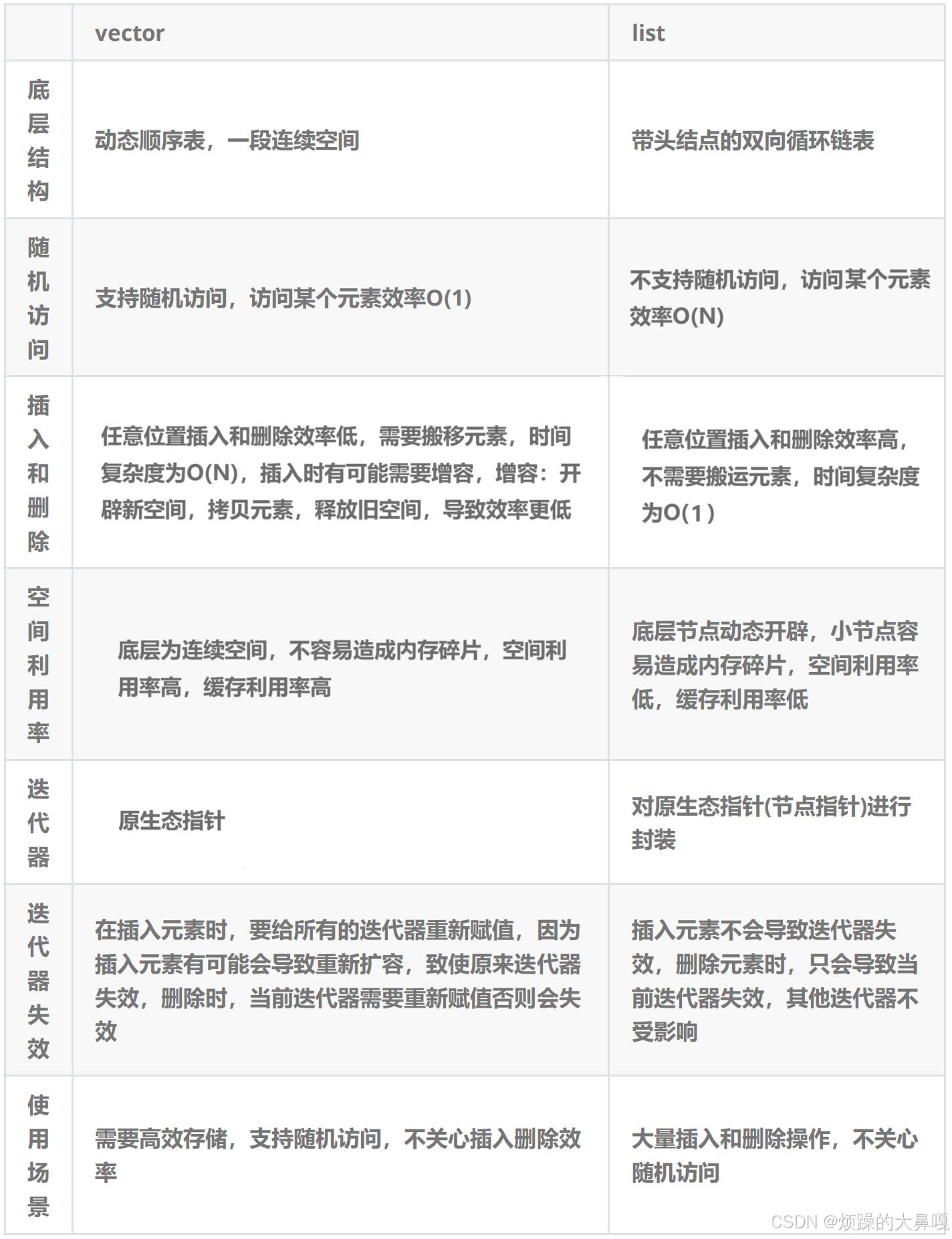1.list概述
相较于 vector 的连续线性空间,list 就显得复杂很多,它的好处是每次插入或删除一个数据,就配置或释放一个元素空间。因此,list 对于空间的运用有绝对的精准,一点也不浪费。对于任何位置的元素进行插入或者元素移除,list 永远是常数时间(O(N))。
list 和 vector 是两个最常被使用的容器,什么时机下最适合使用哪一种容器,必须视元素的多寡、元素的构造复杂度、 元素存取行为的特征而定。
下图是 list 示意图 : 环状链表的尾端加上一个空白节点,符合"前闭后开"区间。
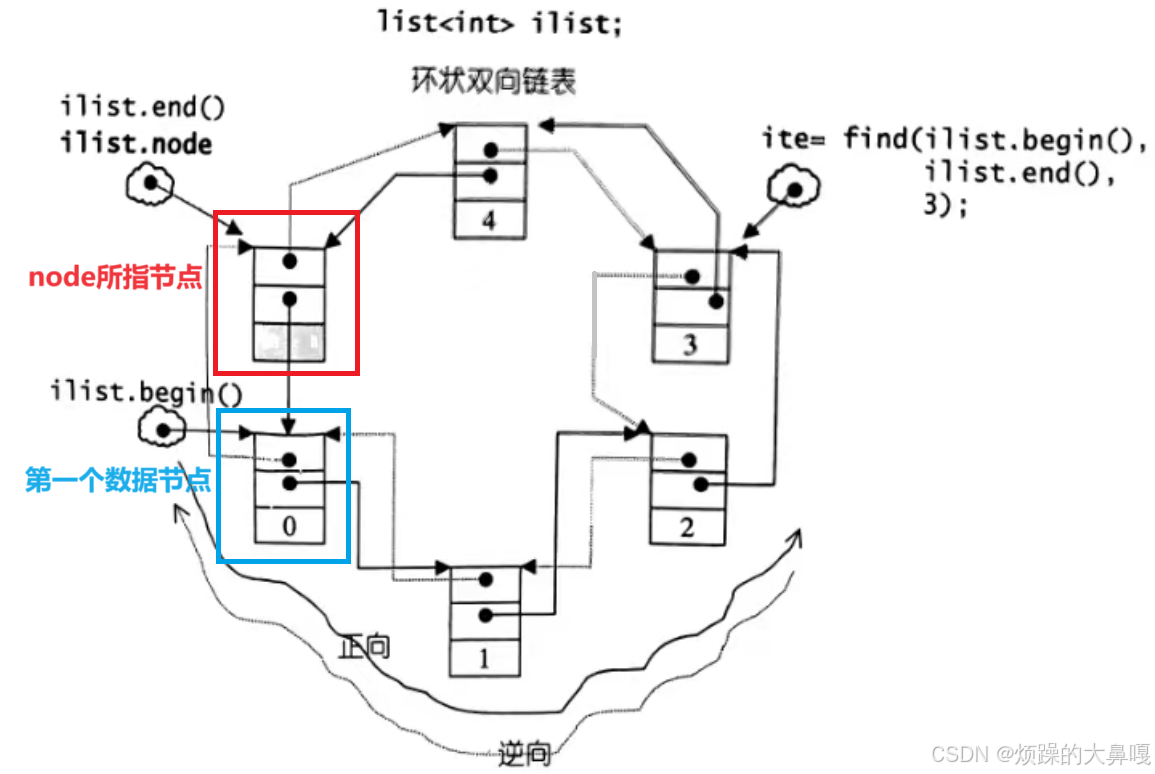
2.list的使用
list 中的接口比较多,此处类似,只需要掌握如何正确的使用,然后再去深入研究背后的原理,已达到可扩展的能力。以下为list中一些常见的重要接口。
(1) list的构造
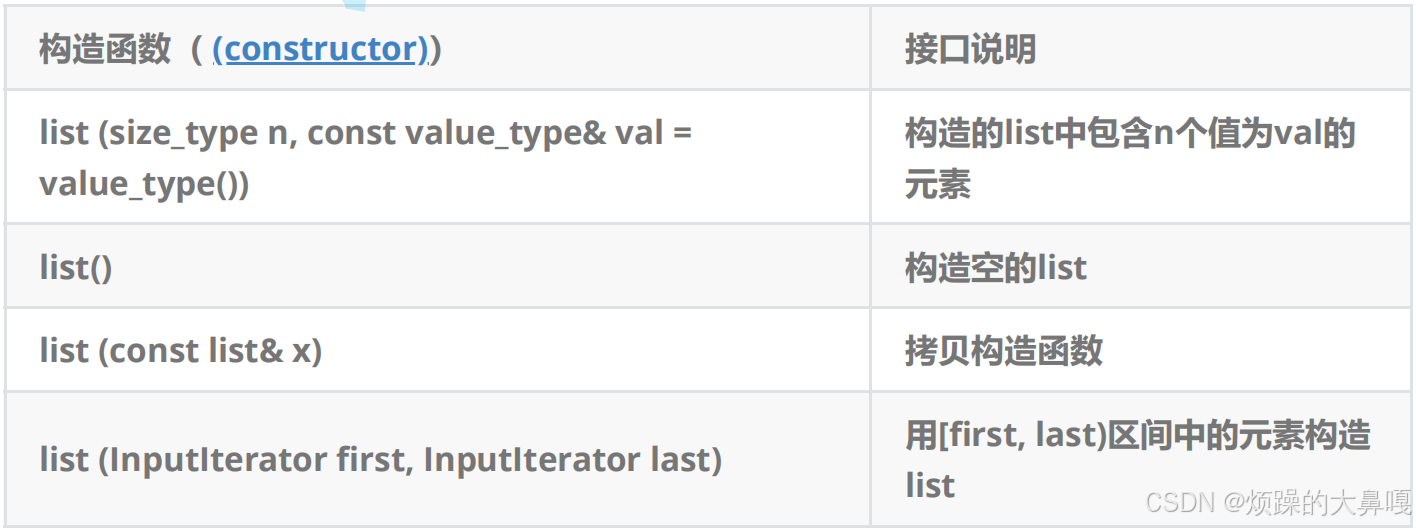
cpp
void TestList1()
{
list<int> l1; // 构造空的l1
list<int> l2(4, 100); // l2中放4个值为100的元素
list<int> l3(l2.begin(), l2.end()); // 用l2的[begin(), end())左闭右开的区间构造l3
list<int> l4(l3); // 用l3拷贝构造l4
// 以数组为迭代器区间构造l5
int array[] = { 16,2,77,29 };
list<int> l5(array, array + sizeof(array) / sizeof(int));
// 列表格式初始化C++11
list<int> l6{ 1,2,3,4,5 };
// 用迭代器方式打印l5中的元素
list<int>::iterator it = l5.begin();
while (it != l5.end())
{
cout << *it << " ";
++it;
}
cout << endl;
// C++11范围for的方式遍历
for (auto& e : l5)
cout << e << " ";
cout << endl;
}(2) list iterator
暂时将迭代器理解成一个指针,该指针指向 list 中的某个节点。


【注意】
- begin 与 end 为正向迭代器,对迭代器执行++操作,迭代器向后移动
- rbegin(end) 与 rend(begin) 为反向迭代器,对迭代器执行++操作,迭代器向前移动
cpp
// list迭代器的使用
// 注意:遍历链表只能用迭代器和范围for
void PrintList(const list<int>& l)
{
// 注意这里调用的是list的 begin() const,返回list的const_iterator对象
for (list<int>::const_iterator it = l.begin(); it != l.end(); ++it)
{
cout << *it << " ";
// *it = 10; 编译不通过
}
cout << endl;
}
void TestList2()
{
int array[] = { 1, 2, 3, 4, 5, 6, 7, 8, 9, 0 };
list<int> l(array, array + sizeof(array) / sizeof(array[0]));
// 使用正向迭代器正向list中的元素
// list<int>::iterator it = l.begin(); // C++98中语法
auto it = l.begin(); // C++11之后推荐写法
while (it != l.end())
{
cout << *it << " ";
++it;
}
cout << endl;
// 使用反向迭代器逆向打印list中的元素
// list<int>::reverse_iterator rit = l.rbegin();
auto rit = l.rbegin();
while (rit != l.rend())
{
cout << *rit << " ";
++rit;
}
cout << endl;
}(3) list capacity

(4) list element access(元素访问)

(5) list modifiers(修改器)
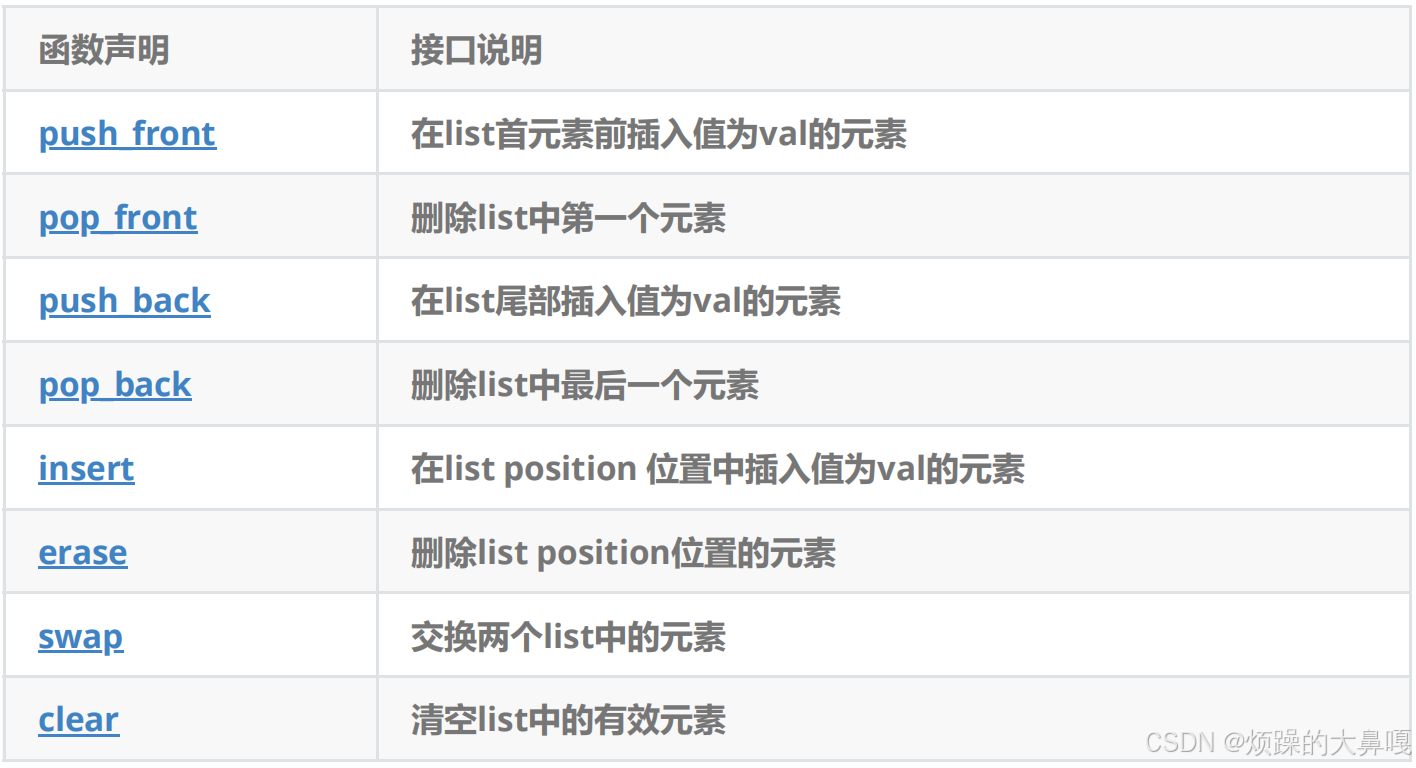
cpp
#include <list>
#include <iostream>
#include <algorithm>
using namespace std;
int main()
{
list<int> ilist;
cout << "size=" << ilist.size() << endl;// size=0
ilist.push_back(0);
ilist.push_back(1);
ilist.push_back(2);
ilist.push_back(3);
ilist.push_back(4);
cout << "size=" << ilist.size() << endl;//size=5
list<int>::iterator ite;
for (ite = ilist.begin(); ite != ilist.end(); ++ite)
{
cout << *ite << ' ';//0 1 2 3 4
}
cout << endl;
ite = find(ilist.begin(), ilist.end(), 3);
if (ite != ilist.end())
{
ilist.insert(ite, 99);
}
cout << "size=" << ilist.size() << endl;// size=6
cout << *ite << endl;// 3
for (ite = ilist.begin(); ite != ilist.end(); ++ite)//0 1 2 99 3 4
cout << *ite << ' ';
cout << endl;
ite = find(ilist.begin(), ilist.end(), 1);
if (ite != ilist.end())
cout << *(ilist.erase(ite)) << endl;//2
for (ite = ilist.begin(); ite != ilist.end(); ++ite)//0 2 99 3 4
cout << *ite << ' ';
cout << endl;
}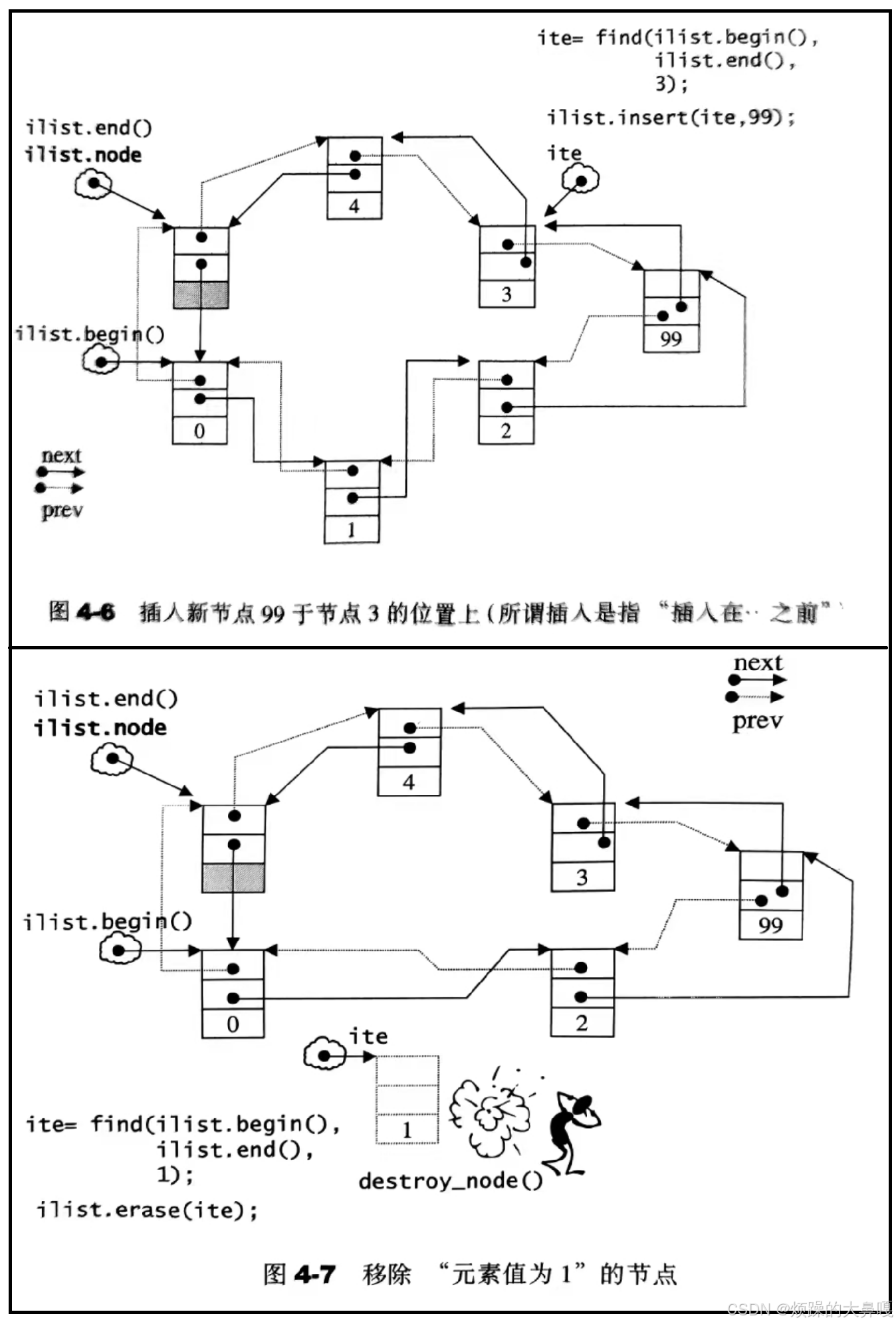
(6) list迭代器失效
前面说过,此处可将迭代器暂时理解成类似于指针,迭代器失效即迭代器所指向的节点的无效,即该节点被删除了。因为list的底层结构为带头结点的双向循环链表,因此在 list 中进行插入时是不会导致 list 的迭代器失效的,只有在删除时才会失效,并且失效的只是指向被删除节点的迭代器,其他迭代器不会受到影响。这在 vector 是不成立的,因为 vector 的常茹操作可能造成记忆体重新配置,导致原有的迭代器全部失效。
cpp
void TestListIterator1()
{
int array[] = { 1, 2, 3, 4, 5, 6, 7, 8, 9, 0 };
list<int> l(array, array + sizeof(array) / sizeof(array[0]));
auto it = l.begin();
while (it != l.end())
{
// erase()函数执行后,it所指向的节点已被删除,
// 因此it无效,在下一次使用it时,必须先给其赋值
l.erase(it);
++it;
}
}
// 改正
void TestListIterator()
{
int array[] = { 1, 2, 3, 4, 5, 6, 7, 8, 9, 0 };
list<int> l(array, array + sizeof(array) / sizeof(array[0]));
auto it = l.begin();
while (it != l.end())
{
l.erase(it++); // it = l.erase(it);
}
}3.list的模拟实现
(1) list的节点(ListNode)
**list 本身和 list 的节点是不同的结构,需要分开设计,以下是根据 STL 设计的 list 的节点(**ListNode )结构:
cpp
template <class T>
struct ListNode // struct默认成员是公有的
{
ListNode(const T& val = T())
:_prev(nullptr)
,_next(nullptr)
,_data(val)
{}
ListNode<T>* _prev;
ListNode<T>* _next;
T _data;
};(2) list的迭代器(ListIterator)
list 不能再像 vector 一样以普通指针作为迭代器,因为其节点不保证在存储空间里连续存在。list迭代器必须有能力指向list节点,并有能力进行正确的递增、递减、取值、成员存取等操作。所谓"list 正确的递增、递减、取值、成员存取"操作是指,递增时指向下一个节点,递减时指向下一个节点,取值时取的是节点的数据值,成员取用时取的是节点的成员。
由于STL list是一个双向链表,迭代器必须具备迁移,后移的能力,所以 list 提供的是 Birdirectional Iterator(双向)
List 的迭代器迭代器有两种实现方式,具体应根据容器底层数据结构实现:
1. 原生态指针,比如:vector
2. 将原生态指针进行封装,因迭代器使用形式与指针完全相同,因此在自定义的类中必须实现以下方法:
(1)指针可以解引用,迭代器的类中必须重载 operator*()
(2)指针可以通过->访问其所指空间成员,迭代器类中必须重载 oprator->()
(3)指针可以++向后移动,迭代器类中必须重载 operator++() 与 operator++(int)
至于 operator--() / operator--(int) 释放需要重载,根据具体的结构来抉择,双向链表可以向前 移动,所以需要重载,如果是forward_list(单向)就不需要重载--
(4)迭代器需要进行是否相等的比较,因此还需要重载 operator==() 与 operator!=()
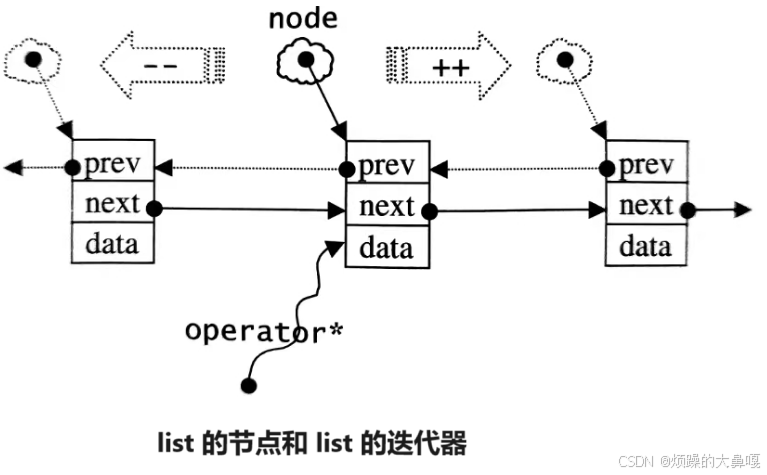
cpp
//List的迭代器类模版,实例化了两个类
template<class T, class Ref, class Ptr>
class ListIterator
{
typedef ListNode<T>* PNode;
typedef ListIterator<T, Ref, Ptr> Self;
public:
ListIterator(PNode pNode = nullptr)
:_pNode(pNode)
{}
ListIterator(const Self& l)
:_pNode(l._pNode)
{}
T& operator*()
{//取得是节点的数值
return (*_pNode)._data;
}
T* operator->()
{
return &(operator*());
}
Self& operator++()
{
_pNode = (*_pNode)._next;
return *this;
}
Self operator++(int)//前置++
{
Self tmp = *this;
_pNode = (*_pNode)._next;
return tmp;//返回++之前的
}
Self& operator--()
{
_pNode = (*_pNode)._prev;
return *this;
}
Self operator--(int)
{
Self tmp = *this;
_pNode = _pNode._prev;
return tmp;//返回++之前的
}
bool operator!=(const Self& l)
{
return !(_pNode == l._pNode);
}
bool operator==(const Self& l)
{
return _pNode == l._pNode;
}
PNode _pNode;//迭代器的内部要有一个普通指针,指向list的节点
};(3) list的数据结构
STL list 不仅是一个双向链表,而且还是一个环状双向链表。所以它只需要一个指针,就可以完整表现整个链表。
cpp
//list类
template<class T>
class list // class 默认是私有的
{
typedef ListNode<T> Node;
public:
typedef Node* PNode;
//实现...
private:
PNode _pHead;//只需要一个指针,完成整个双向环状链表
size_t _size;//STL中没有,自己实现为了方便加的
};(4) list的构造与内存管理
如果将指针刻意置于尾端的一个空白节点,_pHead便能符合STL对于"前闭后开"去区间的要求,成为 list 迭代器。
cpp
// List的构造
list()
{
CreateHead();//产生一个空链表(一个指向自己的空节点)
}
list(int n, const T& value = T())
{
CreateHead();
while (n--)
{
push_back(value);
}
}
template <class Iterator>
list(Iterator first, Iterator last)
{
CreateHead();
while (first != last)
{
push_back(*first);
first++;
}
}
//深拷贝
list(const list<T>& l)
{
CreateHead();
list<T> tmp(l.begin(), l.end());
swap(tmp);
}
list<T>& operator=(list<T> l)
{
swap(l);
return *this;
}
~list()
{
clear();
delete[] _pHead;
_pHead = nullptr;
}
private:
void CreateHead()
{
_pHead = new Node[1];//配置一个节点空间,头尾指向自己
_pHead->_next = _pHead;
_pHead->_prev = _pHead;
}当我们以 push_back( )将新元素插入于list尾端时,此时函数内部调用 insert( ) :
cpp
void push_back(const T& val){ insert(end(), val);}insert( ) 是一个重载函数,有多种形式,其中最简单的一种如下,首先配置并构造一个节点,然后在尾端进行适当的指针操作,将新节点插入进去:
cpp
// 在pos位置前插入值为val的节点
iterator insert(iterator pos, const T& val)
{
PNode tmp = new Node[1];
tmp->_data = val;
PNode pcur = pos._pNode->_prev;
pcur->_next = tmp;
tmp->_prev = pcur;
pos._pNode->_prev = tmp;
tmp->_next = pos._pNode;
++_size;
return tmp;
}插入完成之后,新节点将位于插入点所指向之节点的前方---这是STL对于"插入操作"的标准规范。
(5) list的元素操作
list 提供的元素操作有很多,这里只实现部分操作。
cpp
// List Modify
void push_back(const T& val)
{
insert(end(), val);
}
void pop_back()
{
erase(--end());
}
void push_front(const T& val)
{
insert(begin(), val);
}
void pop_front()
{
erase(begin());
}
// 在pos位置前插入值为val的节点
iterator insert(iterator pos, const T& val)
{
PNode tmp = new Node[1];
tmp->_data = val;
PNode pcur = pos._pNode->_prev;
pcur->_next = tmp;
tmp->_prev = pcur;
pos._pNode->_prev = tmp;
tmp->_next = pos._pNode;
++_size;
return tmp;
}
// 删除pos位置的节点,返回该节点的下一个位置
iterator erase(iterator pos)
{
PNode pcur = pos._pNode->_prev;
PNode pnext = pos._pNode->_next;
pcur->_next = pnext;
pnext->_prev = pcur;
delete[] pos._pNode;
--_size;
return pnext;
}
//清除整个链表
void clear()
{
auto cur = begin();
while (cur != end())
{
cur = erase(cur);
}
}(6) 模拟实现.h
cpp
#include<iostream>
#include<list>
#include<algorithm>
#include<assert.h>
using namespace std;
namespace zyt
{
//List的节点类
template <class T>
struct ListNode // struct默认成员是公有的
{
ListNode(const T& val = T())
:_prev(nullptr)
, _next(nullptr)
, _data(val)
{}
ListNode<T>* _prev;
ListNode<T>* _next;
T _data;
};
//List的迭代器类模版,实例化了两个类
template<class T, class Ref, class Ptr>
class ListIterator
{
typedef ListNode<T>* PNode;
typedef ListIterator<T, Ref, Ptr> Self;
public:
ListIterator(PNode pNode = nullptr)
:_pNode(pNode)
{}
ListIterator(const Self& l)
:_pNode(l._pNode)
{}
T& operator*()
{
return (*_pNode)._data;
}
T* operator->()
{
return &(operator*());
}
Self& operator++()
{
_pNode = (*_pNode)._next;
return *this;
}
Self operator++(int)//前置++
{
Self tmp = *this;
_pNode = (*_pNode)._next;
return tmp;//返回++之前的
}
Self& operator--()
{
_pNode = (*_pNode)._prev;
return *this;
}
Self operator--(int)
{
Self tmp = *this;
_pNode = _pNode._prev;
return tmp;//返回++之前的
}
bool operator!=(const Self& l)
{
return !(_pNode == l._pNode);
}
bool operator==(const Self& l)
{
return _pNode == l._pNode;
}
PNode _pNode;
};
//list类
template<class T>
class list // class 默认是私有的
{
typedef ListNode<T> Node;
typedef Node* PNode;
public:
typedef ListIterator<T, T&, T*> iterator;
typedef ListIterator<T, const T&, const T&> const_iterator;
public:
///
// List的构造
list()
{
CreateHead();//产生一个空链表(一个指向自己的空节点)
}
list(int n, const T& value = T())
{
CreateHead();
while (n--)
{
push_back(value);
}
}
template <class Iterator>
list(Iterator first, Iterator last)
{
CreateHead();
while (first != last)
{
push_back(*first);
first++;
}
}
//深拷贝
list(const list<T>& l)
{
CreateHead();
list<T> tmp(l.begin(), l.end());
swap(tmp);
}
list<T>& operator=(list<T> l)
{
swap(l);
return *this;
}
~list()
{
clear();
delete[] _pHead;
_pHead = nullptr;
}
///
// List Iterator
iterator begin()
{
return ((*_pHead)._next);
}
iterator end()
{
return _pHead;
}
const_iterator begin() const
{
return ((*_pHead)._next);
}
const_iterator end() const
{
return _pHead;
}
///
// List Capacity
size_t size()const
{
return _size;
}
bool empty()const
{
return _pHead->_next == _pHead;
}
// List Access
T& front()
{
return *begin();
}
const T& front()const
{
return *begin();
}
T& back()
{
return *end();
}
const T& back()const
{
return *end();
}
// List Modify
void push_back(const T& val)
{
insert(end(), val);
}
void pop_back()
{
erase(--end());
}
void push_front(const T& val)
{
insert(begin(), val);
}
void pop_front()
{
erase(begin());
}
// 在pos位置前插入值为val的节点
iterator insert(iterator pos, const T& val)
{
PNode tmp = new Node[1];
tmp->_data = val;
PNode pcur = pos._pNode->_prev;
pcur->_next = tmp;
tmp->_prev = pcur;
pos._pNode->_prev = tmp;
tmp->_next = pos._pNode;
++_size;
return tmp;
}
// 删除pos位置的节点,返回该节点的下一个位置
iterator erase(iterator pos)
{
PNode pcur = pos._pNode->_prev;
PNode pnext = pos._pNode->_next;
pcur->_next = pnext;
pnext->_prev = pcur;
delete[] pos._pNode;
--_size;
return pnext;
}
//清除整个链表
void clear()
{
auto cur = begin();
while (cur != end())
{
cur = erase(cur);
}
}
void swap(list<T>& l)
{
std::swap(_pHead, l._pHead);
std::swap(_size, l._size);
}
private:
void CreateHead()
{
_pHead = new Node[1];//配置一个节点空间,头尾指向自己
_pHead->_next = _pHead;
_pHead->_prev = _pHead;
}
private:
PNode _pHead;
size_t _size;
};
}(7) 测试.cpp
cpp
// 打印各类容器(类)
template<class T>
void PrintList(const zyt::list<T>& l)
{
auto it = l.begin();
while (it != l.end())
{
cout << *it << " ";
++it;
}
cout << endl;
}
void TestList3()
{
int array[] = { 1, 2, 3, 4, 5 };
//zyt::list<int> l(array, array + sizeof(array) / sizeof(array[0]));
zyt::list<int> l;
l.push_back(1);
l.push_back(2);
l.push_back(3);
l.push_back(4);
l.push_back(5);
PrintList(l);
auto pos = l.begin();
l.insert(l.begin(), 0);
PrintList(l);
++pos;
l.insert(pos, 2);
PrintList(l);
l.erase(l.begin());
l.erase(pos);
PrintList(l);
// pos指向的节点已经被删除,pos迭代器失效
cout << *pos << endl;
auto it = l.begin();
while (it != l.end())
{
it = l.erase(it);
}
cout << l.size() << endl;
}
// PushBack()/PopBack()/PushFront()/PopFront()
void TestList2()
{
// 测试PushBack与PopBack
zyt::list<int> l;
l.push_back(1);
l.push_back(2);
l.push_back(3);
PrintList(l);
l.pop_back();
l.pop_back();
PrintList(l);
l.pop_back();
cout << l.size() << endl;
// 测试PushFront与PopFront
l.push_front(1);
l.push_front(2);
l.push_front(3);
PrintList(l);
l.pop_front();
l.pop_front();
PrintList(l);
l.pop_front();
cout << l.size() << endl;
}
// 测试List的构造
void TestList1()
{
zyt::list<int> l1;
zyt::list<int> l2(10, 5);
PrintList(l2);
int array[] = { 1, 2, 3, 4, 5, 6, 7, 8, 9, 0 };
zyt::list<int> l3(array, array + sizeof(array) / sizeof(array[0]));
PrintList(l3);
zyt::list<int> l4(l3);
PrintList(l4);
l1 = l4;
PrintList(l1);
}
int main()
{
TestList1();
return 0;
}4.list与vector的区别
vector 与 list 都是STL中非常重要的序列式容器,由于两个容器的底层结构不同,导致其特性以及应用场景不同,其主要不同如下:
